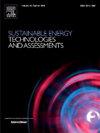Divulging the future of sustainable energy: Innovations and challenges in algal biodiesel production for green energy
IF 7.1
2区 工程技术
Q1 ENERGY & FUELS
Sustainable Energy Technologies and Assessments
Pub Date : 2025-03-01
DOI:10.1016/j.seta.2025.104266
引用次数: 0
Abstract
Algae, often hailed as the tiny superheroes of the aquatic world, have garnered significant attention for their ability to produce sustainable and eco-friendly biodiesel, presenting a promising alternative to traditional fossil fuels. This review examines the current state of algal biodiesel production, addressing key challenges such as strain selection, high production costs, and environmental impact, and proposing solutions to guide future research in renewable energy. The production process typically involves open raceway ponds or closed photo-bioreactors, followed by harvesting, drying, and lipid extraction, with innovative methods like ultra-sonication in situ synthesis offering high-quality biodiesel. The review clarifies the roles of catalysts in the transesterification process and fatty acid methyl esterase (FAME) generation and stress-induced production, as well as the distinction between direct and indirect transesterification methods. The heterogeneous catalysts in transesterification have improved the purity of biodiesel and decreased processing times, while genetic modifications and nanotechnology-like innovative methodology have increased lipid production. According to economic estimates, high production costs remain a hurdle if the worldwide algae biofuel industry is estimated to be worth USD 8.38 billion in 2022. However, the financial viability may be enhanced by the co-production of value-added products (VAPs), projected to reach USD 53.43 billion by 2026. Despite significant advancements in the field, this paper showed the widespread adoption of algal biodiesel as a sustainable energy source using genetic engineering, coagulation-flocculation, synthetic biology, and biorefinery-based production to overcome technological and economic constraints focused on the last. Strong regulatory support and ongoing innovation are necessary to achieve large-scale viability.

揭示可持续能源的未来:绿色能源藻类生物柴油生产的创新和挑战
藻类通常被誉为水生世界的微型超级英雄,它们生产可持续和环保的生物柴油的能力引起了人们的极大关注,这是传统化石燃料的一种有前途的替代品。本文综述了藻类生物柴油生产的现状,解决了菌株选择、高生产成本和环境影响等关键挑战,并提出了指导未来可再生能源研究的解决方案。生产过程通常包括开放的环形池塘或封闭的光生物反应器,然后是收获、干燥和脂质提取,采用超声波原位合成等创新方法,提供高质量的生物柴油。综述了催化剂在酯交换过程中的作用,脂肪酸甲基酯酶(FAME)的生成和应激诱导生产,以及直接和间接酯交换方法的区别。在酯交换反应中,多相催化剂提高了生物柴油的纯度,减少了处理时间,而基因修饰和纳米技术等创新方法增加了脂质产量。根据经济估计,如果到2022年全球藻类生物燃料产业估计价值83.8亿美元,那么高昂的生产成本仍然是一个障碍。然而,联合生产增值产品(vap)可能会提高财务可行性,预计到2026年将达到534.3亿美元。尽管该领域取得了重大进展,但本文展示了藻类生物柴油作为一种可持续能源的广泛采用,利用基因工程、混凝-絮凝、合成生物学和基于生物炼制的生产来克服技术和经济上的限制。强有力的监管支持和持续的创新是实现大规模可行性的必要条件。
本文章由计算机程序翻译,如有差异,请以英文原文为准。
求助全文
约1分钟内获得全文
求助全文
来源期刊

Sustainable Energy Technologies and Assessments
Energy-Renewable Energy, Sustainability and the Environment
CiteScore
12.70
自引率
12.50%
发文量
1091
期刊介绍:
Encouraging a transition to a sustainable energy future is imperative for our world. Technologies that enable this shift in various sectors like transportation, heating, and power systems are of utmost importance. Sustainable Energy Technologies and Assessments welcomes papers focusing on a range of aspects and levels of technological advancements in energy generation and utilization. The aim is to reduce the negative environmental impact associated with energy production and consumption, spanning from laboratory experiments to real-world applications in the commercial sector.
 求助内容:
求助内容: 应助结果提醒方式:
应助结果提醒方式:


